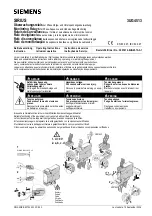
D.7
Date Code 20170814
Instruction Manual
SEL-700G Relay
DNP3 Communications
DNP3 in the SEL-700G
In both the unsolicited report-by-exception and quiescent polling methods
shown in Table D.5, you must make a selection for the PUNSOLn setting.
This setting enables or disables unsolicited data reporting at power up. If your
DNP3 master can send a message to enable unsolicited reporting on the
SEL-700G, you should set PUNSOLn to No.
While automatic unsolicited data transmission on power up is convenient, this
can cause problems if your DNP3 master is not prepared to start receiving data
immediately on power up. If the master does not acknowledge the unsolicited
data with an Application Confirm, the device resends the data until the
information is acknowledged. On a large system, or in systems where the
processing power of the master is limited, you may have problems when
several devices simultaneously begin sending data and waiting for
acknowledgment messages.
The SEL-700G allows you to set the conditions for transmitting unsolicited
event data on a class-by-class basis. It also allows you to assign points to event
classes on a point-by-point basis (see DNP3 Documentation on page D.12).
You can prioritize data transmission with these event class features. For
example, you might place high-priority points in Event Class 1 and set it with
low thresholds (NUMEVEn and AGEEVEn settings) so that changes to these
points are sent to the master quickly. You can then place low priority data in
Event Class 2 with higher thresholds.
If the SEL-700G does not receive an Application Confirm in response to
unsolicited data, it waits for ETIMEOn seconds and then repeats the
unsolicited message. To prevent clogging of the network with unsolicited data
retries, the SEL-700G uses the URETRYn and UTIMEOn settings to increase
retry time when the number of retries set in URETRYn is exceeded. After
URETRYn has been exceeded, the SEL-700G pauses UTIMEOn seconds and
then transmits the unsolicited data again. Figure D.1 provides an example with
URETRYn = 2.
Figure D.1
Application Confirmation Timing With URETRYn = 2
Collision Avoidance
If your application uses unsolicited reporting on a serial network, you must
select a half-duplex medium or a medium that includes carrier detection to
avoid data collisions. EIA-485 two-wire networks are half-duplex. EIA-485
four-wire networks do not provide carrier detection, while EIA-232 systems
can support carrier detection. DNP3 LAN/WAN uses features of the IP suite
for collision avoidance, so does not require these settings.
The SEL-700G uses Application Confirmation messages to guarantee delivery
of unsolicited event data before erasing the local event data buffer. Data
collisions are typically resolved when messages are repeated until confirmed.
The SEL-700G pauses for a random delay between the settings MAXDLY and
MINDLY when it detects a carrier through data on the receive line or the CTS
pin. For example, if you use the settings of 0.10 seconds for MAXDLY and
0.05 seconds for MINDLY, the SEL-700G inserts a random delay of 50 to 100
ms (milliseconds) between the end of carrier detection and the start of data
transmission (see Figure D.2).
RX DATA
(Event Data Confirmation)
TX DATA
ETIMEOn
Retry
Retry
Retry
Confirmation
UTIMEOn
UTIMEOn
ETIMEOn
Содержание SEL-700G Series
Страница 14: ...This page intentionally left blank ...
Страница 22: ...This page intentionally left blank ...
Страница 32: ...This page intentionally left blank ...
Страница 52: ...This page intentionally left blank ...
Страница 106: ...This page intentionally left blank ...
Страница 510: ...This page intentionally left blank ...
Страница 560: ...This page intentionally left blank ...
Страница 578: ...This page intentionally left blank ...
Страница 588: ...This page intentionally left blank ...
Страница 604: ...This page intentionally left blank ...
Страница 634: ...This page intentionally left blank ...
Страница 738: ...This page intentionally left blank ...
Страница 802: ...This page intentionally left blank ...
Страница 816: ...This page intentionally left blank ...
















































